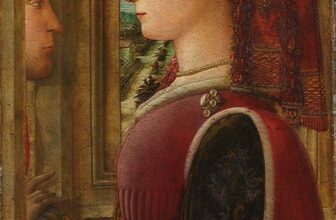
The Abbey in the Oakwood by Caspar David Friedrich
A Profound Journey into the Sublime
Caspar David Friedrich’s The Abbey in the Oakwood (German: Abtei im Eichwald) is one of the most evocative and haunting masterpieces of the Romantic period. Painted between 1809 and 1810, this large-scale oil on canvas composition is more than a simple landscape, it is a visual symphony of death, transience, faith, and the sublime. Housed today in the Alte Nationalgalerie in Berlin, The Abbey in the Oakwood remains a seminal work in understanding the soul of German Romanticism and the complex relationship between humanity and nature in Friedrich’s vision.
In this story post, we will delve deep into the meaning of The Abbey in the Oakwood, analyze its symbolic language, explore its historical and philosophical context, and examine why this painting continues to captivate audiences centuries after its creation.
Introduction to the Painting
The Abbey in the Oakwood is a nearly six-foot-wide canvas showing a desolate, wintery landscape. A group of monks or hooded figures carries a coffin through the ruins of a Gothic abbey, surrounded by barren oak trees. A soft, eerie light emerges from the sky, illuminating the scene with an almost spiritual glow. There is no sunshine, no warmth, only the pale ambiance of dusk or perhaps dawn. It is a painting enveloped in silence, where every element seems to mourn the passage of time.
The Historical and Artistic Context
Friedrich painted this work during a period when Romanticism was rising as a reaction to the Enlightenment’s emphasis on reason and the industrialization transforming European society. Artists, poets, and philosophers of the Romantic period sought solace and meaning in nature, spirituality, memory, and emotion.
Born in 1774, Friedrich grew up in the midst of these cultural shifts, and his work often reflects deep introspection, melancholy, and spiritual longing. He lost his mother at a young age and later witnessed the drowning of his younger brother, traumas that left indelible marks on his artistic psyche. These life experiences informed his preoccupation with death, the afterlife, and the sublime.
Visual Description of the Scene
At first glance, The Abbey in the Oakwood may appear to be a bleak and somber landscape, but its richness lies in its details:
The Trees: Bare, ancient oaks dominate the foreground. These are not lush trees of life but twisted, gnarled skeletons reaching out into the cold air. They represent age, endurance, and perhaps decay.
The Abbey: The Gothic ruins are central to the painting. The once majestic structure now stands broken and lifeless, its arched windows and spires crumbling, overtaken by time and nature. The abbey acts as a symbol of a lost era, perhaps a metaphor for the fading influence of organized religion or the persistence of faith amidst ruin.
The Monks: A procession of monks in dark cloaks walks solemnly toward the church, carrying a coffin. Their presence provides a human element, evoking themes of ritual, mourning, and the passage into the next life.
The Sky: The sky is a dusky palette of grays and blues, neither completely dark nor entirely light. It suggests a liminal space, a threshold between night and day, life and death, earthly suffering and divine mystery.
What is Happening in the Painting?
The narrative within The Abbey in the Oakwood is subtle and shrouded in mystery. A funeral procession is taking place in the ruins of a long-abandoned abbey. The figures are likely monks, possibly Capuchins, which Friedrich included in other works. They carry a coffin to what seems to be a final resting place within the abbey’s crumbling walls.
But more than the act of burial, the painting captures a metaphysical transition. It speaks to the end of life and the endurance of the spirit. The viewer is not just witnessing a funeral but a meditation on death itself, set within the stark vastness of winter, nature’s own season of death.
Symbolism in The Abbey in the Oakwood
Symbolism saturates every corner of Friedrich’s work. Here are some of the primary symbolic elements:
a. The Oak Trees
In Germanic mythology and Christian symbolism alike, the oak is a powerful tree, representing endurance, strength, and sacredness. However, in this context, the trees are barren and lifeless, symbolizing death, decay, and the passage of time. They surround the abbey like silent sentinels, witnesses to the past and the ephemeral nature of human achievements.
b. The Abbey Ruins
The Gothic church, now a hollow shell, stands as a stark reminder of the impermanence of human constructs. Yet it also suggests the persistence of faith. Even in ruins, the abbey still serves its purpose, a sacred space for burial. The architecture mirrors the aspirations of the human soul reaching toward the divine, even when the body of the church is broken.
c. The Coffin and Funeral Procession
The funeral is not merely a ritual but an allegory. The monks symbolize a spiritual journey. The coffin could represent the artist himself, or humanity as a whole, confronting the ultimate fate. In Friedrich’s view, death is not to be feared, but embraced as part of the natural order and perhaps even as a sacred transition.
d. Light in Darkness
The faint glow in the sky is one of the most powerful elements of the painting. Despite the coldness and death on the ground, the heavens remain open. This subtle light is Friedrich’s gesture of hope, symbolizing the divine, the afterlife, or the enduring spark of the human soul.
Philosophical and Religious Interpretation
Friedrich was a deeply spiritual man, and his art often reflects Lutheran ideals. In The Abbey in the Oakwood, one can interpret the painting as an expression of Protestant mysticism: a direct relationship between the individual and God, mediated not by ornate churches but by the awe of nature.
Moreover, the ruined abbey could be seen as a critique of institutional religion. In the Romantic imagination, the divine was not confined to buildings but existed in the natural world. Friedrich’s depiction of faith persisting even within decay suggests a transcendental understanding of spirituality.
From a philosophical standpoint, Friedrich engages with ideas from Immanuel Kant and Edmund Burke about the sublime, those experiences in nature that are so vast and overwhelming they transcend rational understanding. The painting is sublime not in its terror, but in its stillness, its capacity to evoke emotion beyond reason.
The Type of Art: German Romanticism
The Abbey in the Oakwood is a quintessential example of German Romanticism, a movement that emphasized emotion, individuality, nature, and the sublime. Friedrich’s work differs from the more flamboyant French Romanticism seen in Delacroix; his is quieter, more introspective, and steeped in Northern European melancholia.
Romanticism, particularly in Germany, was deeply influenced by literature, music, and philosophy. Friedrich’s painting is often described as “painterly poetry”, a visual counterpart to the works of Goethe, Novalis, or Schiller. It invites viewers not to marvel at technical skill alone, but to feel, to reflect, and to search for meaning.
The Painting’s Reception and Legacy
At the time of its unveiling, Friedrich’s work garnered mixed reactions. His somber tones and religious symbolism did not appeal to everyone in an era increasingly driven by rationalism and classical ideals. However, critics and philosophers like Carl Gustav Carus and Heinrich von Kleist admired Friedrich’s unique ability to evoke the ineffable.
Today, The Abbey in the Oakwood is considered a masterwork of Romanticism. It has inspired generations of artists, filmmakers, and thinkers who see in Friedrich’s vision a timeless meditation on mortality and the sacred. It is frequently cited in discussions of the Romantic sublime and remains a fixture in art history curricula around the world.
Where Is the Abbey in the Oakwood Painting Today?
The Abbey in the Oakwood is part of the permanent collection of the Alte Nationalgalerie (Old National Gallery) in Berlin, Germany. The museum houses one of the most important collections of 19th-century art in the world, and Friedrich’s painting is among its crown jewels.
The painting’s size and impact make it a centerpiece in the museum’s Romantic art section. Visitors to the Alte Nationalgalerie often remark on the emotional intensity and contemplative stillness the painting evokes even in the busy modern world.
A Painting That Transcends Time
Caspar David Friedrich’s The Abbey in the Oakwood is more than a landscape, it is a profound spiritual and philosophical statement. Through his mastery of composition, light, and symbolism, Friedrich invites us into a world where death is not an end, but a gateway; where ruins speak louder than cathedrals; and where nature is both beautiful and humbling.
In a time where noise and speed dominate, The Abbey in the Oakwood reminds us of the importance of stillness, of reflection, and of accepting the cycles of life and death with reverence. Friedrich painted not just what he saw, but what he felt and believed. And in doing so, he created a timeless work that continues to speak to the human soul with quiet, eternal resonance.




